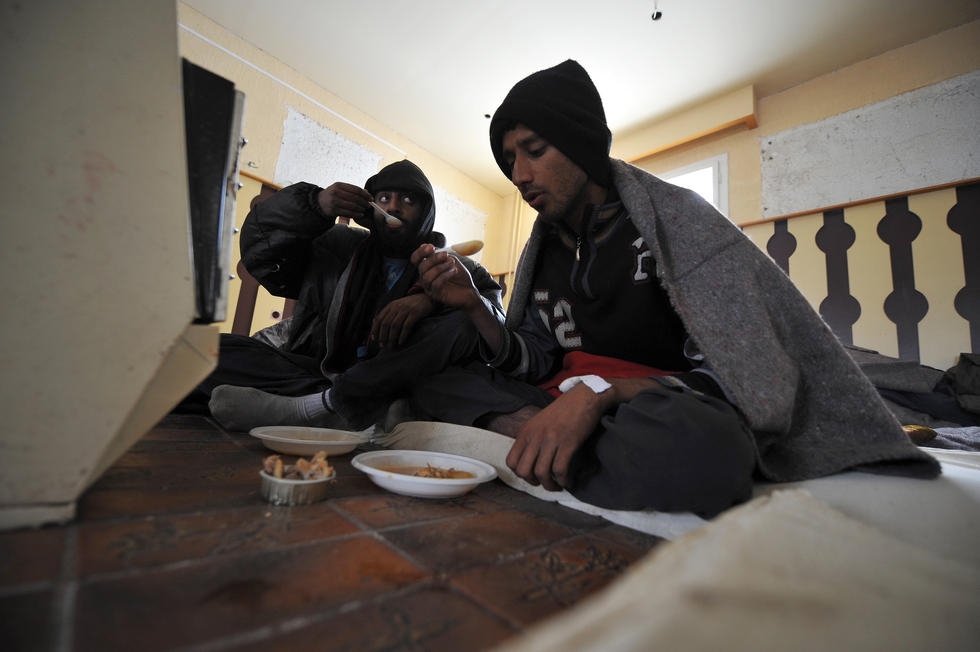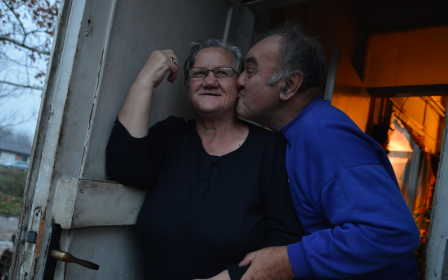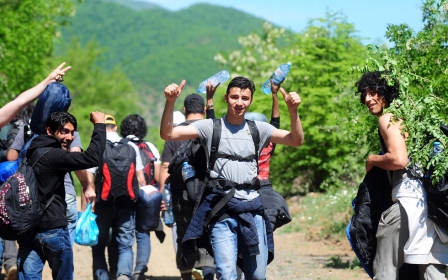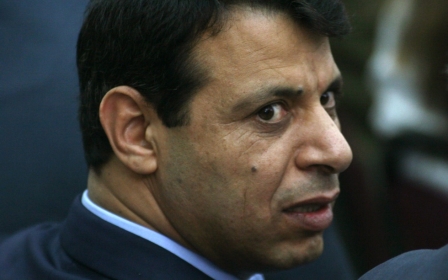Serbia: EU’s migration and asylum stopgap

BELGRADE – Luka Celovic Park in central Belgrade, down by the capital’s main bus station, used to be filled with streetwalkers. They would huddle here day and night and frequent cheap hotels and smoke-filled cafes, earning the otherwise green and leafy park an unpublishable nickname.
In recent weeks, however, the streetwalkers and their clients have been pushed out, leaving almost no trace that they ever ruled this otherwise unimpressive part of town.
The tide of migrants and refugees - as well as smugglers and profiteers who feed off them - has been so intense of late that the park has now earned itself another reputation entirely.
On any given day, there are somewhere between 150 to 300 refugees and migrants camping here in the heart of the Serbian capital. As many as 100 stay the night. Almost all come from Syria, Iraq and Afghanistan and have made this patch of turf next to Belgrade’s bus terminal their temporary home before travelling north to places like Germany.
There are scores of families with young children seeking shade here, as well as large groups of men who hang out in clusters of between five and 20. The locals look on at the park’s new residents and make passing comments but they largely walk on unphased, knowing that Serbia is a so-called “transit country” for migrants.
The vast majority of those now camping out here will leave in just a few days and 99 percent will be gone within a few months. But with migration along the Western Balkan route at an all-time high and growing, and with EU states looking to step up controls on its borders to stem the flow, this giant conveyor belt of people threatens to grind to a halt.
While there has long been a trickle of media coverage of the issue, last week saw an explosion of stories about Syrians in the country, covering everything from playing pool with migrants to Syrians love of Serbian baked delicacies to the abuses many experience at the hands of local police and exploitative hoteliers.
The mixed response is indicative of a wider situation, which has left Serbia caught in the middle and trying to reconcile its hopes for EU membership with strict EU border policy demands, as well as the fate of the new arrivals with the legacy of the Yugoslav wars in the early 1990s and the NATO-led campaign in 1999 that continue to bear a deep mark on the country.
The half way line
In the first four months of this year, almost 40,000 people made their way along the so-called Western Balkan migration route in hope of reaching one of the wealthier EU states. Many came from Kosovo and Albania, but Syrians, Afghans and Iraqis also made the journey.
The voyage is a treacherous one, dominated by smugglers and criminals. Many report being robbed, beaten and illegally detained by gangs. By the time they reach Belgrade, almost all say they are exhausted and financially drained.
Walid, who fled the Syrian side of the Israeli-occupied Golan Heights with his wife and four young children, says that he used to own a successful cigar and tobacco shop, but after paying smugglers $4,000 each to get him to the Serbian border, he has nothing left. “What the smugglers didn’t take, criminals stole,” he said.
Walid and his family now sleep in the park, biding their time while they figure out how to make it to Germany.
In principle, the situation here is better than many other parts of the Balkans.
Police do detain migrants, but most of the time they look the other way. At the park, police stroll through, occasionally asking people to move on and doing little once they return.
Serbia also has a nascent but developing asylum system and those who register are allowed to access a network of open asylum centres where they can come and go relatively freely. They are hardly luxurious, but offer free meals and basic services like legal aid and medical care, which is given free to all registered asylum seekers and is amongst the best care in Eastern Europe, according to MSF.
Crucially, however, Serbia is not a signatory of the Dublin Convention which dictates EU asylum laws and states that all asylum seekers must be registered and fingerprinted in the country where they are first found, dooming their chances of applying in their desired country.
All of this has contributed to a steep uptick in asylum applications. In the first four months of this year, 16,500 people registered their intent to seek asylum in Serbia, and UNHCR expects that by the end of the year, at least 30,000 will have done so. This will be more than double the numbers seen in 2014 and almost five times more than in 2013.
But this is the best case scenario, especially for those without ample sums to back them, and abuses are reported every step of the way.
The road to Serbia
Walid’s journey to Serbia was a relatively typical one. His family were crammed onto tiny boats and dropped off in Albania. A smuggler took them to the Macedonia border and left them to make it to Serbia on foot.
Walid says that in Macedonia, he was held at gunpoint and robbed while his family watched. He had hoped Serbia would be better, but things quickly turned sour.
“The policeman asked us if we were Muslims. When we said yes, he said he was too and gave us some food and let us get warmed up,” said Walid.
Once the family had eaten, however, the policeman took them to the border and told them to return to Macedonia. “When we refused, he fired into the air to make us,” Walid said. “We were scared because we have [also] heard that they [the police] beat people up.”
The government denies all such allegations and points to the fact that not a single case of police misconduct has been reported. A recent HRW report though has documented dozens of testimonials alleging this kinds of abuse.
“We have had repeated reports of refugees being ordered to walk to the direction of Macedonia,” Emina Cerimovic, a Koenig fellow at Human Rights Watch who focuses on migration told Middle East Eye.
“So people who are apprehended and arrested in the south are told to go and to not come back. But there is no justification for this. They are violating Serbian law, EU law and international law. The local laws [on protecting refugees] are actually pretty clear, but they are not being enforced.”
HRW has also recorded testimonials alleging instances of police brutality. Some migrants and refugees claim to have been beaten up, and others say that they have had their money taken. MSF says it has treated many patients with injuries, but admits it cannot verify whether police or thugs inflicted the damage.
Rados Djurovic, head of the Belgrade-based Asylum Protection Centre, argues that individual abuses happen but they are by no means “systemic” and says that the growth in asylum applications should act as a case in point that while the system could be improved, it is working.
What worries him and other NGOs the most, however, is the growth in the migration flow and the subsequent strengthening of trafficking networks.
“As more people travel through the Western Balkans, the smugglers will continue to grow ever richer from the misery and desperation of others,” said Stephane Moissaing, Doctors Without Borders (MSF) coordinator of all Serbia projects. MSF offers free medical care to migrants and refugees across the country.
Smuggler heaven
There are already signs that the networks are growing bolder. In recent weeks, there have been a string of high-profile car crashes in which migrants and refugees have been piled into unsafe vehicles which have swerved off the road. Dozens have been badly injured and others killed.
In cafes near the park, smugglers operate freely. They casually walk into cafes, now exclusively frequented by migrants, and advertise their business in broken English.
Aid agencies are also growing concerned that this kind of smuggling activity could lead to a rise in people smuggling.
Activists, journalists and aid workers privately admit that some elements of the police must be working with the smugglers, or at least paying them to look the other way, but no one has publically been able to prove this as yet.
Instead, the situation build ups until an incident forces a crackdown, although with more people entering every single day, it’s not long before migrants and smugglers pop up elsewhere.
“I don’t know how much longer the situation at the park will be allowed to continue,” said Moissaing. “I expect that within a few weeks, the police will step in.”
Local responses
The local populations’ response so far has been varied. Protests have been breaking out periodically across the country since 2011.
In one instance, villagers in Mladenovac in central Serbia barricaded a compound with tractors to stop development of a planned detention centre. In another, protests were sparked by reports that an Afghani migrant had raped a foreign journalist in Banja Koviljaca, close to the Bosnian border. He has not been found guilty, but the story quickly gained traction and safety is now a common concern.
“What will a regional centre for asylum seekers do for us?” ask flyers handed out by local committee in western Serbia. “It will only bring problems will health, security, falling property prices, population exodus, as well as the blackest fears about infection, rape, attacks, drug abuse, prostitution and leave us living in constant fear.”
On occasion, a right-wing group called the Dveri have fanned fears and helped to ignite demonstrations. A group of politicians, including those for the centre-left Democratic Party, have also advocated against migrants on economic and safety grounds although the issue has not reached the kind of fever pitch seen in places like Greece and there are few political points to be earned by blaming migrants for the country’s various ills.
“Serbia is not like some other parts of the West and we are still relatively pro-asylum,” said Djurovic. “People here know that these are just people with the same hopes and dreams and they are not terrorists which is not the case in many other parts of the Balkans.”
“My organisation [and others] has successfully been able to make the case that people here need to be treated humanely, not because we have to, but because we have lived through this context.”
“Maybe people don’t want migrants to be their neighbours, but they fully recognise these are people in need,” he added.
While hatreds can run deep here, they tend to be reserved for groups like the LGBT community, Albanians and Croats and, on occasion, NATO and the EU.
The fallout from the Yugoslav Wars in the 1990s and the NATO-led military campaign in 1999 have left deep scars. According to UNHCR, there are still 220,000 internally displaced people, largely ethnic Serbs and a further 40,000 refugees who fled from places like Bosnia and Croatia as the ex-Yugoslavia was falling apart and later from Kosovo as it sought independence. This is down from highs of around million in the 1990s but many continue to need state and international assistance, and their welfare remains a priority in a country which is struggling to make ends meet economically and where many complain of being poorer today than they were 20 years ago. After decades of sanctions, the economy briefly improved in the 2000s after President Slobodan Milosevic’s overthrow, but has flat lined since 2008.
Goran, a Belgrade taxi driver, has driven groups of migrants to the border for $250 for the two-hour journey. He says that, like many of his colleagues, he was happy for the extra income, but now with the number of migrants sleeping in the capital’s park growing, he’s becoming concerned.
“I feel sorry for them. We [Serbs] understand what it is like to live through war, but we can’t support them. We can’t even support ourselves. I don’t know how much longer this can continue,” he said.
EU pushback
Like almost everything else in Serbia, what will ultimately happen depends on the EU and the larger and wealthier states where the overwhelming majority of migrants and refugees want to settle.
If the EU starts offering generous handouts to Serbia, or start taking in larger amounts of refugees and migrants, Serbia could continue to act as an imperfect pipeline. This is certainly the option new arrivals would like to see happen.
“I have a degree and I want to work,” said one refugee in his early 30s who had been camping out in the park for days.
“I had money, but the smugglers took it all. If the EU had opened its borders, I could have paid good money for a work visa and worked. But now I have nothing.”
At present, this option looks unlikely. While Berlin and Brussels have been pushing for a quota system to be introduced, the UK, Spain and France have all but ruled out the plan. Instead, talks are underway about launching military intervention against smugglers.
This commitment to “Fortress Europe” threatens to push the issue down the road to places like Serbia which is already starting to feel the knock-on effects.
As migration began to spike earlier this year, the EU put pressure on Serbia to tighten its border, prompting it to send elite police units north. The Germans also sent 20 of its police to Hungary, while Hungary is eyeing plans to roll out its army to secure the border.
As a result, fewer people are chancing it alone and coming into Hungary on foot. This means more and more are paying smugglers to help them navigate the restrictions.
The consequences are two-fold. As aid agencies fear, the smugglers may grow richer and bolder, most likely forcing people to stay in Serbia for a longer period of time in order to pay for passage out. If they do, Serbia’s parks could find themselves even fuller and its fragile asylum system and social balance tested to the max.
(Part III of this report focuses on the fragile conditions at the asylum centres and the humanitarian crisis on the northern border)
New MEE newsletter: Jerusalem Dispatch
Sign up to get the latest insights and analysis on Israel-Palestine, alongside Turkey Unpacked and other MEE newsletters
Middle East Eye delivers independent and unrivalled coverage and analysis of the Middle East, North Africa and beyond. To learn more about republishing this content and the associated fees, please fill out this form. More about MEE can be found here.




